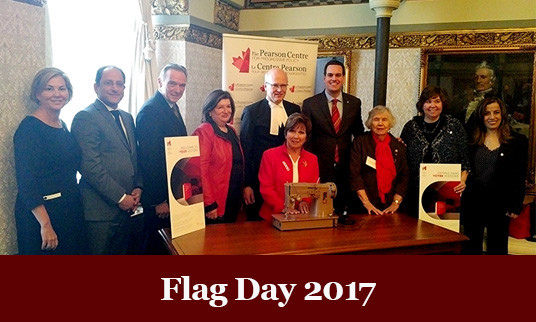March 28, 2017
Flag Day on the Hill (Regan, O’Malley, Ehsassi, Kent, Weir, Pearson, etc.; Feb 15)
By
From VIDEOS: https://www.youtube.com/channel/UCbceGf4FA5NxXuYv0qNwsow/videos

Date: February 15, 2017
L to R: Karen Ludwig, MP, Ali Ehsassi, MP, Hon. Peter Kent, MP. Beatrice Raffoul, Speaker Geoff Regan, Joan O’Malley (seamstress who sewed the first maple leaf flag in 1964), Erin Weir, MP, former Senator Landon Pearson, Anita Vandenbeld, MP, Eva Nassif, MP
VIDEOS: https://www.youtube.com/channel/UCbceGf4FA5NxXuYv0qNwsow/videos
Reception on Flag Day, February 15, 2017
Co-Hosted by Speaker Geoff Regan and the Pearson Centre
1. Beatrice Keleher Raffoul from the Pearson Centre welcomed guests and introduced Speaker Regan
2. The Hon. Geoff Regan
3. Joan O’Malley
4. Beatrice introduced three Co-Chairs to share their thoughts about the flag
5. Ali Ehsassi, MP
6. The Hon. Peter Kent, MP
7. Erin Weir, MP,
8. Sen Landon Pearson
9. Andrew Cardozo adjourned event
___________________________________________________________________________________________________________________________________
DISCOURS DE L’HON. GEOFF REGAN
Jour du drapeau – 15 février 2017
(English version follows)
Chers parlementaires, mesdames et messieurs. Au nom du Centre Pearson pour des politiques progressistes et en mon propre nom, j’aimerais vous souhaiter la bienvenue à cette merveilleuse célébration du drapeau.
C’est un honneur pour moi d’animer cet événement.
Comme certains le savent peut-être, j’ai un lien très personnel avec le drapeau.
Mon père était député de Halifax en 1964 lorsque le premier ministre Pearson a enclenché le processus qui a mené à la sélection d’un drapeau représentant le Canada.
En fait, mon père a voté en faveur du motif qui est aujourd’hui reconnu de par le monde non seulement comme symbole du Canada, mais aussi comme symbole de la paix et de la bonne volonté de son peuple.
George Stanley, qui a créé le motif qui a été choisi, a dit que le drapeau du Canada devait servir de symbole de rassemblement et de force unificatrice.
Bien que ce soit certainement le cas aujourd’hui, le débat entourant le choix du motif de notre drapeau a été long, vigoureux et parfois très animé.
Les parlementaires savaient qu’il s’agissait d’une décision historique et déterminante pour notre pays, une décision qui allait non seulement former un pays, mais qui allait aussi invariablement façonner la perception qu’aurait le monde entier de notre pays.
Et d’une façon qu’on ne peut qualifier que de typiquement canadienne, nous en sommes venus à une décision ensemble, au moyen de discussions et de consensus.
Depuis, notre drapeau nous a unis comme peuple en nous procurant une identité commune et un sentiment d’unité nationale.
Malgré tout ce qu’on sait relativement à la naissance de ce symbole exclusivement canadien, de nombreuses personnes ignorent l’histoire de notre tout premier drapeau.
Un vendredi de l’automne 1964, le premier ministre Pearson a demandé les prototypes des trois motifs ultimes pris en considération pour les examiner à sa résidence du lac Harrington pendant le week-end.
La demande aboutit au bureau de M. Ken Donovan, un fonctionnaire au ministère aujourd’hui appelé Services publics et Approvisionnement Canada.
Sans les services d’une couturière et compte tenu de l’échéancier très serré, M. Donovan a demandé à sa fille, Joan O’Malley, de coudre les prototypes pour le premier ministre.
Les drapeaux ont été livrés à temps, et, comme on dit, le reste fait maintenant partie de l’histoire.
J’ai le privilège d’accueillir Mme O’Malley et de l’inviter à dire quelques mots sur son expérience remarquable.
__________________________________________________________________________________________________________________________________
SPEECH BY SPEAKER GEOFF REGAN
Flag Day – February 15, 2017
Fellow parliamentarians, ladies and gentlemen, on behalf of Pearson Centre for Progressive Policy and all parliamentarians, I would like to welcome you today to this wonderful celebration of the Flag.
It’s an honour for me to be hosting with the Honourable Ali Ehsassi, the Honourable Peter Kent, and the Honourable Erin Weir.
As some of you may know, I have a very personal connection to the flag.
My father was Member of Parliament for Halifax in 1964 when Prime Minister Pearson began the process of selecting a flag to represent Canada.
In fact, my father voted in favour of the design that is now immediately recognizable world-wide as a symbol not only of Canada, but of the peace and goodwill of its people.
Of course, had my father voted against the design, I might not be highlighting his involvement to the same extent…
George Stanley, who created the design that was ultimately chosen, said that Canada’s flag should “serve as a rallying symbol and hence be a unifying force.”
Although that is certainly true now, the debate surrounding the choice of design of our flag was lengthy, vigorous and at times quite heated.
Parliamentarians knew that this was a historic and crucial decision for our country; one that would not only shape us a nation, but would also invariably shape the way we, as a nation, are perceived by the world.
And in a way that can only be called quintessentially Canadian, we came to a decision together through discussion and consensus.
In the years since, our flag has brought us closer together as people, providing us with a shared identity and a sense of national unity.
Despite all that is known about the birth of this uniquely Canadian symbol, many people don’t know the story of the very first flag.
On a Friday in the fall of 1694, Prime Minister Pearson requested prototypes of the three final designs of the flag being considered to take up to his Harrington Lake residence for the weekend.
The request landed on the desk of Mr. Ken Donovan, a public servant with what is now Public Services and Procurement Canada.
Without a seamstress on hand and with a very tight deadline looming, Mr. Donovan asked his daughter, Joan O’Malley, to sew the flag prototypes for the Prime Minister.
The flags were delivered on time, and the rest, as they say, is history.
It is my privilege to welcome Ms. O’Malley and invite her to say a few words about her remarkable experience.



